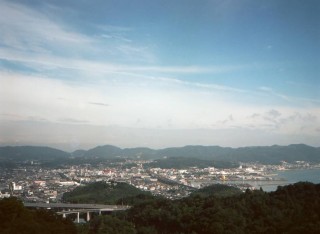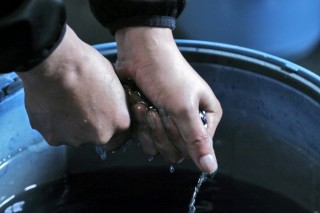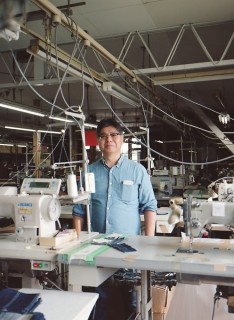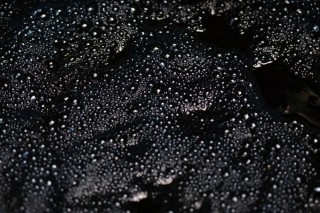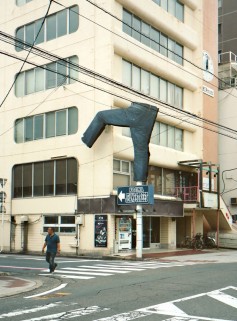Loading
Search
▼ Denim Dreams: Dyeing to Live in The Industrial Heart of Okayama
- Category:Experience
Hirohiko Sunami’s hands emerge from his indigo vat covered in rivulets of fermenting natural dye. The light is dim in this Kojima workshop, but a few stray sunbeams reflect off the millions of bubbles at the vat’s surface as Sunami pulls a piece of cotton from the dark liquid. “Look,” he says. While we watch, the color seems to change as the dye oxidizes.
Before Sunami moved here to dye denim, before this town made the nation’s school uniforms, before its textile factories were built and before the land was planted with cotton seeds, Kojima was a good-for-nothing tract of soggy, salty earth on the shores of Japan’s inland sea, the Setonaikai. Today, this mundane coastal town at the southern end of Okayama Prefecture, with a population of roughly 75,000, is Japan’s “Holy Land of Jeans.”
The first to leave Sunami’s darkened dye workshop is Yasuhiro Oshima, president of the Betty Smith jeans company and son of one of the pioneers of Japanese denim. With the sound of insects in the warm air, he leads the way through a local festival to the oldest jeans factory in Kojima.
Before Sunami moved here to dye denim, before this town made the nation’s school uniforms, before its textile factories were built and before the land was planted with cotton seeds, Kojima was a good-for-nothing tract of soggy, salty earth on the shores of Japan’s inland sea, the Setonaikai. Today, this mundane coastal town at the southern end of Okayama Prefecture, with a population of roughly 75,000, is Japan’s “Holy Land of Jeans.”
The first to leave Sunami’s darkened dye workshop is Yasuhiro Oshima, president of the Betty Smith jeans company and son of one of the pioneers of Japanese denim. With the sound of insects in the warm air, he leads the way through a local festival to the oldest jeans factory in Kojima.
“I was born the same year that this factory was built: 1962,” he says, walking among the rows of sewing machines. “One of my first memories is the sound of the machines, and falling asleep inside the stacks of denim.”
If Kojima is the mecca of Japanese jeans, then this little factory is consecrated ground. Oshima’s father and his colleagues worked tirelessly between the 1960s and 1980s to produce a Japanese version of America’s most enduring fashion export. In the postwar period, second-hand jeans began appearing at black markets in Tokyo and were snapped up quickly by fashion-forward youths, despite the hefty price tag. The allure of dangerous denim only grew stronger when 1950s biker films such as “The Wild One” and “Rebel Without a Cause” appeared.
To make their first pair of jeans in 1965, Oshima’s father and workmates needed to import all the materials from America — including heavy-duty Union Special sewing machines. It wasn’t until the 1970s that their new company, Big John, created the first pair of 100 percent domestically produced jeans, using 14-ounce selvedge denim made in the nearby city of Kurashiki. Oshima points out the artifacts from this period of innovation — sewing machines, washing machines, early denim samples — in the nearby Betty Smith Jeans Museum.
If Kojima is the mecca of Japanese jeans, then this little factory is consecrated ground. Oshima’s father and his colleagues worked tirelessly between the 1960s and 1980s to produce a Japanese version of America’s most enduring fashion export. In the postwar period, second-hand jeans began appearing at black markets in Tokyo and were snapped up quickly by fashion-forward youths, despite the hefty price tag. The allure of dangerous denim only grew stronger when 1950s biker films such as “The Wild One” and “Rebel Without a Cause” appeared.
To make their first pair of jeans in 1965, Oshima’s father and workmates needed to import all the materials from America — including heavy-duty Union Special sewing machines. It wasn’t until the 1970s that their new company, Big John, created the first pair of 100 percent domestically produced jeans, using 14-ounce selvedge denim made in the nearby city of Kurashiki. Oshima points out the artifacts from this period of innovation — sewing machines, washing machines, early denim samples — in the nearby Betty Smith Jeans Museum.
Back then, he says, “no one wanted to show their jeans were made locally. Now that has reversed.”
Spread across Kojima are dozens of dedicated stores and factories that continue to produce their selvedge denim on old-fashioned shuttle looms and dye it with natural indigo — good denim is in the details. Aside from Betty Smith, the descendant of Big John, the major players include Japan Blue Co., which started the legendary Momotaro Jeans and Rampuya & Co. labels, and Kapital, an eccentric brand with multiple stores hidden across the town. Kapital recently published “Denim Friend Book: 100 Useful Phrases” to help non-Japanese talk about jeans once they arrive in Japan. Among the useful phrases it teaches: “It looks like you damaged those on purpose!”
Now Kojima jeans are proudly “Made in Japan,” thanks in part to Okayama Prefecture’s promotion of “industrial tourism,” itself part of a wider industrial turn in travel in Japan. In 2015, UNESCO granted World Heritage status to 23 industrial sites from the Meiji Period (1868-1912). No sites in Okayama Prefecture were awarded heritage status, but that’s likely because the industries here are, against all odds, still breathing.
The town’s low-rise houses and shacks quickly turn to forest on the winding road up to Washuzan’s Hill Viewpoint, which overlooks the town and the sea. It’s late afternoon now and the Setonaikai has turned a deep shade of blue, its many islands stretching out to the horizon, coated in a salty haze. A procession of cars cross the top level of the enormous 13.1-kilometer-long Seto-Ohashi Bridge — a towering display of engineering might — and trains run along its lower level. On the far side of the sea, in Shikoku, a distant factory pumps out fulgent white smoke.
Spread across Kojima are dozens of dedicated stores and factories that continue to produce their selvedge denim on old-fashioned shuttle looms and dye it with natural indigo — good denim is in the details. Aside from Betty Smith, the descendant of Big John, the major players include Japan Blue Co., which started the legendary Momotaro Jeans and Rampuya & Co. labels, and Kapital, an eccentric brand with multiple stores hidden across the town. Kapital recently published “Denim Friend Book: 100 Useful Phrases” to help non-Japanese talk about jeans once they arrive in Japan. Among the useful phrases it teaches: “It looks like you damaged those on purpose!”
Now Kojima jeans are proudly “Made in Japan,” thanks in part to Okayama Prefecture’s promotion of “industrial tourism,” itself part of a wider industrial turn in travel in Japan. In 2015, UNESCO granted World Heritage status to 23 industrial sites from the Meiji Period (1868-1912). No sites in Okayama Prefecture were awarded heritage status, but that’s likely because the industries here are, against all odds, still breathing.
The town’s low-rise houses and shacks quickly turn to forest on the winding road up to Washuzan’s Hill Viewpoint, which overlooks the town and the sea. It’s late afternoon now and the Setonaikai has turned a deep shade of blue, its many islands stretching out to the horizon, coated in a salty haze. A procession of cars cross the top level of the enormous 13.1-kilometer-long Seto-Ohashi Bridge — a towering display of engineering might — and trains run along its lower level. On the far side of the sea, in Shikoku, a distant factory pumps out fulgent white smoke.
The scene is unlike depictions of the Setonaikai by early 20th-century ukiyo-e artists — Yoshida Hiroshi or Tsuchiya Koitsu — but just as beautiful. In their prints, the water is often bathed in pink light, with the cotton sails of fishing boats looking as though they have been dipped in a vat of strawberry milk and lone vessels drifting against the dark shapes of pine-covered landmasses.
“There are too many picturesque islands,” is how U.S. anthropologist Edward Norbeck described the otherworldly scene in the 1950s. “No such tranquil sea could exist. It is a Japanese painting.”
He lived on one of those islands for nearly a year before writing “Takashima: A Japanese Fishing Village” about his experiences in its “picturesque hamlet” — a place of “quiet, peace, and unhurried country life.”
But I felt a slight sense of horror up on Washuzan, knowing what happened when Norbeck returned in the 1970s — and considering what he might think if he were to return today. “A haze of smoke filled the air and extended to the horizon in all directions,” he wrote. “After some moments of inspection I recognized Takashima.” But it was no longer an island. Its pine trees and bamboo grasses were gone, and reclaimed land — on which a factory had been built — now linked it to Mizushima, the site of a former warplane manufacturing plant turned industrial complex. Today, it has been completely swallowed by this “new industrial city.” Mitsubishi Motors Corp. offers free tours of one of its factories here (reservations must be made at least two weeks in advance), where visitors can watch a car being made.
Locals, Norbeck claimed, enjoyed the economic rewards of working in the factories: “The ugliness and pain of past poverty could not be matched by any of the drawbacks of modern times.” He didn’t go into excessive detail, but it’s now clear that these drawbacks include pollution-related health problems, oil and chemical spills and the demise of the local fishing industry.
Industrial tourism is a complicated thing.
Back in Kojima, the streets are quiet. It’s easy to imagine the town as Oshima remembers it being in the 1990s: “Before there were no stores and museums — just factories.” You can also make out older versions of the town along its once-shuttered shopping street, now renamed “Jeans Street,” 1 kilometer from Kojima Station.
“There are too many picturesque islands,” is how U.S. anthropologist Edward Norbeck described the otherworldly scene in the 1950s. “No such tranquil sea could exist. It is a Japanese painting.”
He lived on one of those islands for nearly a year before writing “Takashima: A Japanese Fishing Village” about his experiences in its “picturesque hamlet” — a place of “quiet, peace, and unhurried country life.”
But I felt a slight sense of horror up on Washuzan, knowing what happened when Norbeck returned in the 1970s — and considering what he might think if he were to return today. “A haze of smoke filled the air and extended to the horizon in all directions,” he wrote. “After some moments of inspection I recognized Takashima.” But it was no longer an island. Its pine trees and bamboo grasses were gone, and reclaimed land — on which a factory had been built — now linked it to Mizushima, the site of a former warplane manufacturing plant turned industrial complex. Today, it has been completely swallowed by this “new industrial city.” Mitsubishi Motors Corp. offers free tours of one of its factories here (reservations must be made at least two weeks in advance), where visitors can watch a car being made.
Locals, Norbeck claimed, enjoyed the economic rewards of working in the factories: “The ugliness and pain of past poverty could not be matched by any of the drawbacks of modern times.” He didn’t go into excessive detail, but it’s now clear that these drawbacks include pollution-related health problems, oil and chemical spills and the demise of the local fishing industry.
Industrial tourism is a complicated thing.
Back in Kojima, the streets are quiet. It’s easy to imagine the town as Oshima remembers it being in the 1990s: “Before there were no stores and museums — just factories.” You can also make out older versions of the town along its once-shuttered shopping street, now renamed “Jeans Street,” 1 kilometer from Kojima Station.
One store is caught between eras: its shutters are half pulled. Two elderly women are inside chatting under a fluorescent light. “Yes, we’re open!” says one. They’re selling sweets, soy sauce, noodles and canned coffee — the essentials — out of cardboard boxes. On one wall is a metal door that resembles a safe. Was this a bank? “No, that was a freezer.” But it looks too big. “It is big,” says the other, “there used to be more ice-cream in there than you could eat.” But, like a few of the shops along Jeans Street, it has been empty for years — maybe decades.
Unexpectedly, most of the previously shuttered stores are now open and full of visitors. If you like denim, this is heaven. You can eat “denim” ice-cream (blueberry flavor), wander from workshop to store, chat with owners such as Norihiko Kanazawa, who runs Kamikaze Attack, or try on 29-ounce heavyweight jeans in Kojima Genes.
Like the villagers of Takashima, who Norbeck said preferred the ugliness of modernity to the ugliness of poverty, Kojima has embraced its textile industry and the “ugliness” of manual labor has become a tourist attraction. “Most towns are famous because of their local material,” says Oshima, “but we are famous because of our skills — and machines.”
Kojima disappears in the rearview mirror as the car winds along a densely wooded road that crosses Washuzan. Trees crowd in, but occasionally the forest breaks, offering glimpses of the coruscating lights from the
Mizushima industrial complex below — like reflections on the surface of a bubbling indigo vat.
The full scale of this other type of industry is exposed as we cross a bridge. We slow down to view one of Japan’s top 100 night views — other cars have stopped, and parked against the railing; their lights are off, windows fogged and streaked with condensation. Inside, blurry figures look out at dense, shining clusters of factories, petrochemical plants and refineries.
The sky above is black; below, an engine of modernity powers its own galaxy.
Unexpectedly, most of the previously shuttered stores are now open and full of visitors. If you like denim, this is heaven. You can eat “denim” ice-cream (blueberry flavor), wander from workshop to store, chat with owners such as Norihiko Kanazawa, who runs Kamikaze Attack, or try on 29-ounce heavyweight jeans in Kojima Genes.
Like the villagers of Takashima, who Norbeck said preferred the ugliness of modernity to the ugliness of poverty, Kojima has embraced its textile industry and the “ugliness” of manual labor has become a tourist attraction. “Most towns are famous because of their local material,” says Oshima, “but we are famous because of our skills — and machines.”
Kojima disappears in the rearview mirror as the car winds along a densely wooded road that crosses Washuzan. Trees crowd in, but occasionally the forest breaks, offering glimpses of the coruscating lights from the
Mizushima industrial complex below — like reflections on the surface of a bubbling indigo vat.
The full scale of this other type of industry is exposed as we cross a bridge. We slow down to view one of Japan’s top 100 night views — other cars have stopped, and parked against the railing; their lights are off, windows fogged and streaked with condensation. Inside, blurry figures look out at dense, shining clusters of factories, petrochemical plants and refineries.
The sky above is black; below, an engine of modernity powers its own galaxy.
- June 1, 2017
- Comment (0)
- Trackback(0)


